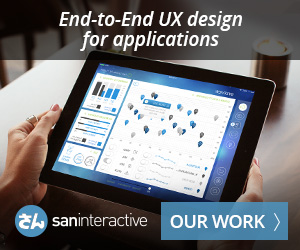Fintech companies have redefined the finance landscape over the past decades. They’ve done that by moving away from the traditional brick-and-mortar institutions and offering innovative digital platforms that simplify our financial interactions. Along with this revolution, UX design has gained prominence in the fintech industry.
Picture this: you land on a fintech website, and everything just clicks. Every button, every piece of information, and every interaction feels like it’s exactly where it should be. Welcome to the world of user experience (UX) design in fintech sites, where aesthetics and functionality blend seamlessly. It’s not just about making things look good; it’s about making your financial journey smooth and intuitive from start to finish.
This article looks into the unique role of UX design in shaping the fintech user journey, its impact on site experiences and the way it manages to navigate common challenges.
The role of UX design in fintech websites
UX design has become a game-changer for fintech websites. Creating an intuitive and user-friendly experience not only builds trust but also cultivates customer loyalty and boosts engagement.
Here are the main contributions of applying UX design to fintech websites.
Simplicity and ease of use
In the complex world of finance, simplification can be an advantage. UX designers in fintech have a critical role in making intricate financial processes accessible. The key is to present information and actions in a straightforward manner, eliminating any potential confusion or frustration.
Take for example Robinhood, who has revolutionized stock trading. With its clean and intuitive app design, even those with limited financial know-how can seamlessly navigate the world of investing.
Building trust and credibility
Trust is the cornerstone of any financial transaction. UX design is instrumental in creating an environment of credibility, transparency and security. A well-designed fintech website instills confidence in users, encouraging them to entrust sensitive financial details.
PayPal offers features like two-factor authentication and encrypted transactions, which help users feel secure while conducting online payments.
Personalization
Fintech companies possess a treasure trove of user data. Leveraging this data, UX designers can personalize experiences to individual needs. This personalization not only enhances UX but also empowers users to make informed financial decisions.
Mint takes personalization to new heights. By analyzing a user’s financial data, the platform offers tailored budgeting tips and financial insights, equipping users with the tools to manage their money more effectively.
Implementing UX design in fintech websites
To better understand the role UX design plays in fintech websites we reviewed the main features and processes affected along the implementation of UX tactics.
Onboarding process
The initial interaction sets the tone for a user’s entire journey. UX designers ensure that registration and verification processes are seamless, reducing friction and enhancing the onboarding experience.
Coinbase is an example of streamlined onboarding process for cryptocurrency trading. With clear instructions and user-friendly identity verification, the platform makes entering the world of crypto hassle-free.
Navigational flow
Intuitive navigation is cardinal for fintech websites. Users should effortlessly locate features such as account information, transactions and support services.
Chime is a great example, with its straightforward navigation system. Users can easily access various banking features, from transferring money to friends to paying bills, or setting up savings goals.
Financial tools and features
UX designers should create intuitive interfaces for the array of financial tools fintech platforms offer. Whether it’s investing, budgeting or credit management, these tools should be user-friendly and accessible.
By enabling users to invest spare change from everyday purchases, Acorns turns investing into an automated and user-friendly task.
Accessibility and inclusivity
A successful UX design should cater to all users regardless of their abilities. It should prioritize inclusivity to provide a seamless experience for everyone. Check out how Wise (formerly TransferWise) champions inclusivity by making its website accessible to users with disabilities, ensuring that no one is left behind in financial transactions.
UX challenges in fintech sites (and how to navigate them)
Security concerns
While essential, strict security measures can sometimes negatively affect user experience. Finding a balance between security and usability is key.
Using solutions like biometric authentication enhances security without compromising convenience. In addition, actively educating users about security measures can also alleviate concerns.
Regulatory compliance
Navigating the regulatory landscape is a big challenge for fintech platforms. Designing with compliance in mind can be complex.
By collaborating closely with compliance experts and legal teams UX experts can ensure that the design adheres to regulations. Transparent explanations can help users understand compliance-related processes.
Data privacy concerns
Collecting user data for personalization can raise privacy concerns. UX designers must address these concerns while delivering personalized experiences by transparently communicating about data collection and usage, along with user-controlled data-sharing options. Anonymizing data whenever possible further enhances privacy.
Market volatility and complexity
Financial markets are highly dynamic and complex. Designing an interface that simplifies data without sacrificing accuracy is a challenge.
Using infographics, charts and concise explanations can be a helpful method to demystify complex financial data and empower users to make informed decisions.
Summary
In the fast evolving fintech industry, UX design emerges as a catalyst for success. Through simplicity, trust-building and personalization, fintech platforms can create an ecosystem that not only attracts users but also keeps them engaged and satisfied. Despite challenges, the best UX design agencies can overcome obstacles by collaborating across departments and championing user-centric solutions. Ultimately, effective UX design in fintech websites supports customer relationships, and helps drive the industry’s growth and innovation into the future.
To maximize the engagement and retention levels of your site visitors and improve their user experience, we recommend that you check our inventory of the best UX agencies from around the world. You can also learn more on how to choose a good UX design agency and what are the most important questions you should ask before hiring a UX agency.








































